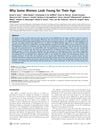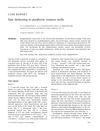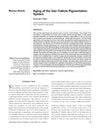TLDR Hair follicle cells age faster and lose pigment due to less catalase, causing hair to turn gray.
The study revealed that human hair follicle melanocytes (HFMs) and epidermal melanocytes (EMs) aged differently, with HFMs showing a more significant decline in proliferation and tyrosinase expression. Catalase expression and activity, important for reducing oxidative stress, were markedly lower in older HFMs, indicating a higher vulnerability to oxidative damage, which may contribute to hair graying. The findings suggested that oxidative stress significantly influenced hair follicle aging and graying, with catalase playing a crucial role in this process.
 175 citations
,
November 2009 in “PLOS ONE”
175 citations
,
November 2009 in “PLOS ONE” Women look young for their age due to larger lips, less sun damage, and genes that prevent gray hair and wrinkles.
217 citations
,
February 2009 in “The FASEB Journal” Gray hair is caused by hydrogen peroxide buildup, which damages hair color repair.
210 citations
,
May 2006 in “The FASEB journal” Oxidative stress causes hair to gray by damaging and killing pigment cells.
 38 citations
,
February 2002 in “British journal of dermatology/British journal of dermatology, Supplement”
38 citations
,
February 2002 in “British journal of dermatology/British journal of dermatology, Supplement” Two patients with porphyria cutanea tarda experienced their grey hair turning dark again.
 April 2023 in “Journal of Investigative Dermatology”
April 2023 in “Journal of Investigative Dermatology” Blocking casein kinase 1 in skin cells can help melanocyte precursors move better, potentially helping with conditions like vitiligo or gray hair.
 240 citations
,
April 2011 in “Pigment Cell & Melanoma Research”
240 citations
,
April 2011 in “Pigment Cell & Melanoma Research” Melanocyte stem cells in hair follicles are key for hair color and could help treat greying and pigment disorders.
 10 citations
,
November 2010 in “Pigment Cell & Melanoma Research”
10 citations
,
November 2010 in “Pigment Cell & Melanoma Research” Only skin melanocytes, not other types, can color hair in mice.
 75 citations
,
January 2009 in “International journal of trichology”
75 citations
,
January 2009 in “International journal of trichology” Hair grays due to oxidative stress and fewer functioning melanocytes.





